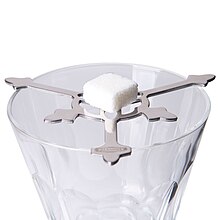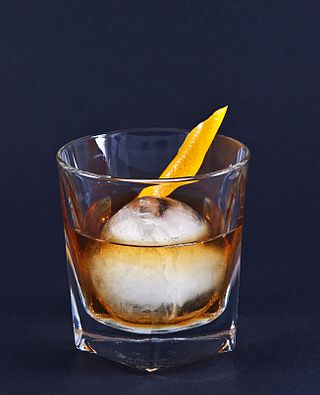
The old fashioned is a cocktail made by muddling sugar with bitters and water, adding whiskey or sometimes brandy, and garnishing with an orange slice or zest and a cocktail cherry. It is traditionally served with ice in an old fashioned glass.
Sour mix is a mixer that is yellow-green in color and is used in many cocktails. It is made from approximately equal parts lemon and/or lime juice and simple syrup and shaken vigorously with ice. This produces a pearly-white liquid with a pronounced flavor.
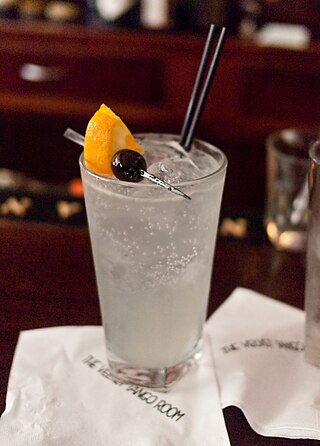
The Tom Collins is a Collins cocktail made from gin, lemon juice, sugar, and carbonated water. First memorialized in writing in 1876 by Jerry Thomas, "the father of American mixology", this "gin and sparkling lemonade" drink is typically served in a Collins glass over ice. A non-alcoholic "Collins mix" mixer is produced, enjoyed by some as a soft drink.
Herbsaint is a brand name of anise-flavored liqueur originally created as an absinthe-substitute in New Orleans, Louisiana in 1934, and currently produced by the Sazerac Company.

French 75 is a cocktail made from gin, champagne, lemon juice, and sugar. It is also called a 75 Cocktail, or in French simply a Soixante Quinze.
Ouzo is a dry anise-flavored aperitif that is widely consumed in Greece. It is made from rectified spirits that have undergone a process of distillation and flavoring. Its taste is similar to other anise liquors like pastis, sambuca, rakı and arak.

The Sazerac is a local variation of a cognac or whiskey cocktail originally from New Orleans, named for the Sazerac de Forge et Fils brand of cognac brandy that served as its original main ingredient. The drink is most traditionally a combination of cognac or rye whiskey, absinthe, Peychaud's Bitters, and sugar, although bourbon whiskey is sometimes substituted for the rye and Herbsaint is sometimes substituted for the absinthe. Some claim it is the oldest known American cocktail, with origins in antebellum New Orleans, although drink historian David Wondrich is among those who dispute this, and American instances of published usage of the word cocktail to describe a mixture of spirits, bitters, and sugar can be traced to the dawn of the 19th century.

Soda jerk is an American term used to refer to a person — typically a young man — who would operate the soda fountain in a drugstore, preparing and serving soda drinks and ice cream sodas. The drinks were made by mixing flavored syrup, carbonated water, and occasionally malt powder over either ice or a few scoops of ice cream. The drink would then be served in a tall glass with a long-handled spoon, most commonly known as a "soda spoon", and drinking straws.

A hot toddy, also known as hot whiskey in Ireland, and occasionally called southern cough syrup within the Southern United States, is typically a mixed drink made of liquor and water with honey, lemon, herbs and spices, and served hot. Recipes vary, and hot toddy is traditionally drunk as a nightcap before retiring for the night, in wet or cold weather or to relieve the symptoms of the cold and flu. In How to Drink, Victoria Moore describes the drink as "the vitamin C for health, the honey to soothe, the alcohol to numb."

A slotted spoon is a spoon implement used in food preparation. The term can be used to describe any spoon with slots, holes or other openings in the bowl of the spoon which let liquid pass through while preserving the larger solids on top. It is similar in function to a sieve; however, a ladle-sized slotted spoon is most typically used to retrieve items from a cooking liquid while preserving the liquid in the pot, while table-sized slotted spoons are often used to serve foods prepared or packaged in juices, such as canned fruit and vegetables.
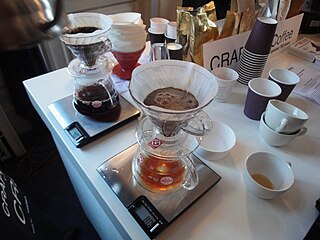
Coffee preparation is the process of turning coffee beans into liquid coffee. While the particular steps vary with the type of coffee and with the raw materials, the process includes four basic steps: raw coffee beans must be roasted, the roasted coffee beans must then be ground, and the ground coffee must then be mixed with hot or cold water for a specific time (brewed), the liquid coffee extraction must be separated from the used grounds, and finally, if desired, the extracted coffee is combined with other elements of the desired beverage, such as sweeteners, dairy products, dairy alternatives, or toppings.
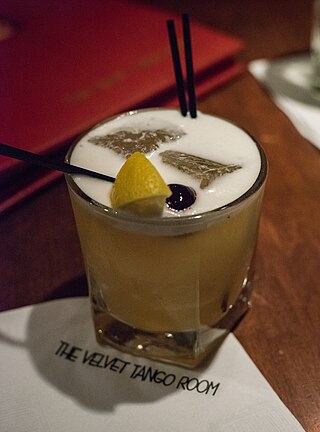
An amaretto sour is a cocktail using amaretto liqueur. It is a type of sour, a mixed drink made with a base spirit, citrus juice, and a sweetener. The drink is the most popular cocktail use for amaretto.

The Pimm's cup is a cocktail that is popular in England, in the United Kingdom. It is one of numerous fruit cups, a type of cocktail with gin, a soft drink, and fruit. Its primary spirit is Pimm's No. 1 Cup, a gin-based beverage flavored with fruits and spices invented around 1823 as a health drink.
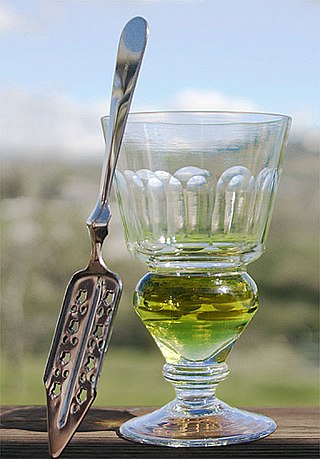
Absinthe is an anise-flavored spirit derived from several plants, including the flowers and leaves of Artemisia absinthium, together with green anise, sweet fennel, and other medicinal and culinary herbs. Historically described as a highly alcoholic spirit, it is 45–74% ABV or 90–148 proof in the US. Absinthe traditionally has a natural green color but may also be colorless. It is commonly referred to in historical literature as la fée verte. While sometimes casually referred to as a liqueur, absinthe is not traditionally bottled with sugar or sweeteners. Absinthe is traditionally bottled at a high level of alcohol by volume, but it is normally diluted with water before being consumed.

Sugar cubes are white sugar granules pressed into small cubes. It is usually used by individuals to sweeten drinks. There are two main ways of using the sugar cubes: directly dissolving the cubes in the drink or placing the cube into the mouth while drinking.
Bohemian-style or Czech-style absinth is a Bohemian version of the traditional spirit absinthe, though it is more accurately described as a kind of wormwood bitters. It is produced mainly in the Czech Republic, from which it gets its designations as “Bohemian” or “Czech,” although not all absinthe from the Czech Republic is Bohemian-style.

The Oxford Companion to Spirits & Cocktails (OCSC) is a book in the series of Oxford Companions published by Oxford University Press. The book provides an alphabetically arranged reference to spirits, cocktails and other elements of the bar industry, compiled and edited by David Wondrich and Noah Rothbaum, with contributions by several writers including Doug Frost, Garrett Oliver and Audrey Saunders. Also notably contributing to the book is pioneering bartender Dale DeGroff. The work is considered the first reference book on the history and trends of distilled spirits.


